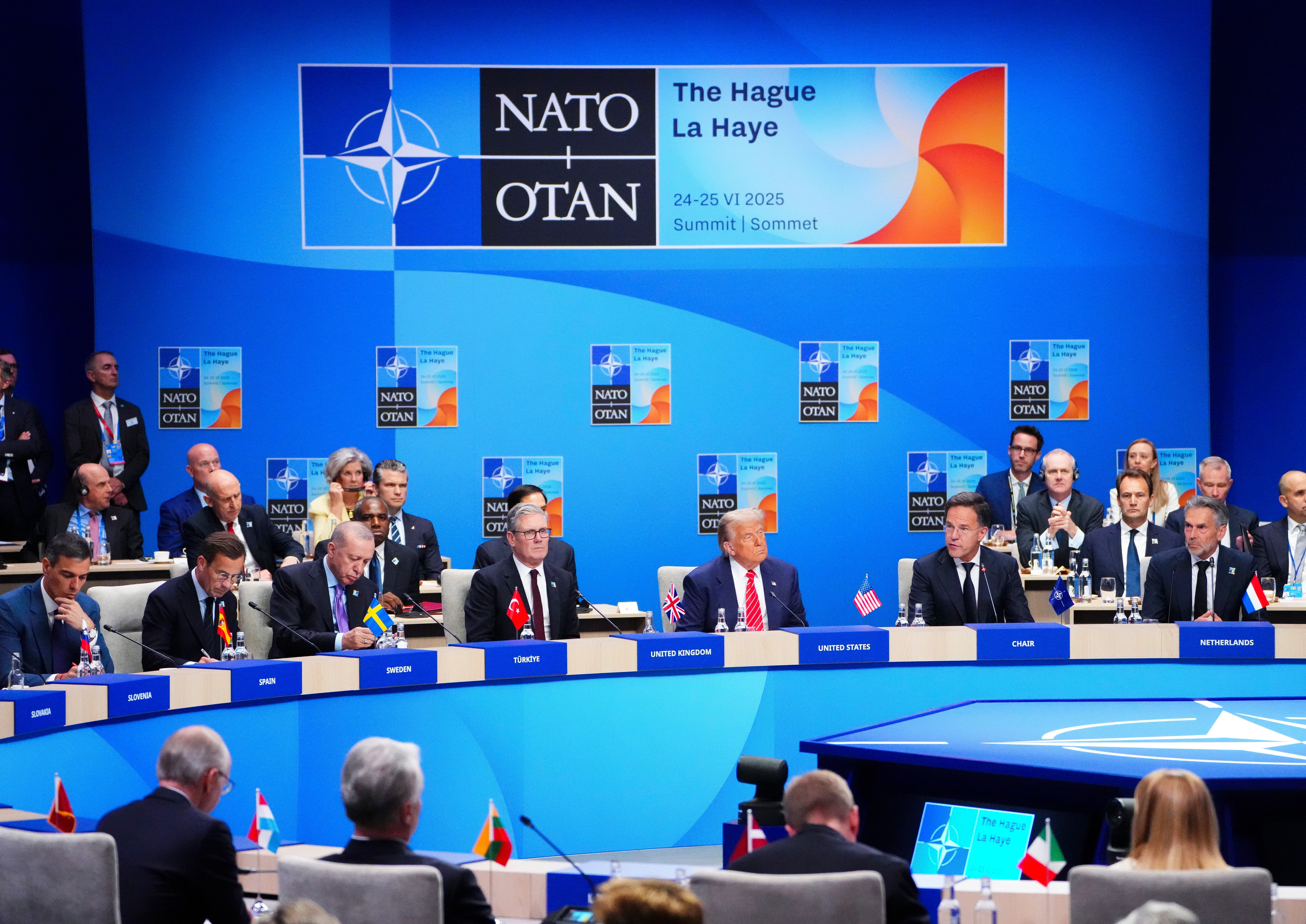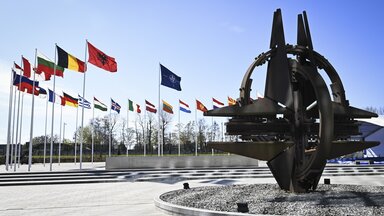Summit in The Hague
Takeaways NATO The Hague Summit

NATO Secretary General Mark Rutte, center right, gives the opening speech as he sits next to US President Donald Trump during a meeting of the North Atlantic Council at the NATO summit in The Hague.
© picture alliance / ASSOCIATED PRESS | Sean KilpatrickThe NATO Summit in The Hague was eagerly anticipated. Despite the volatile global situation, the agenda for the meeting of heads of state and government was reduced to a single item due to concerns over visible disagreements — especially with US President Trump. Instead of addressing the various current crises, the focus was almost exclusively on agreeing to increased defense spending. As a result, this year’s final declaration is significantly shorter than that of the 2024 Washington Summit, containing only 5 sections compared to the previous 38, some of which had numerous sub-points.
What is in the The Hague Summit Declaration?
The traditional summit declaration contains four substantive points, two of which concern the level of defense spending. Here, NATO memberstates agreed that all countries should increase their defense and security expenditures to 5% of GDP by 2035. Of this, 3.5% is allocated to “traditional” defense spending according to NATO’s narrower definition, while 1.5% is for critical infrastructure, civil protection, resilience improvements, and strengthening the defense industry. While it was agreed to review in 2029 how far countries have progressed toward these goals and to align the targets with the threat environment, the specifics and timeline for reaching the 5% goal by 2035 are left to the member states themselves.
Additionally, the final declaration includes various reaffirmations and assurances. These are typically standard in such declarations, but during the Trump administration, their mere inclusion is considered a small success. Thus, the current summit declaration reaffirms the collective defense commitment and expresses intent to further expand cooperation in military and defense industry matters—though, unlike in previous summit declarations, the latter is not elaborated in detail.
Compromises on Russia and Ukraine
There was considerable anticipation as to whether NATO would be able to find a common language in the final communiqué regarding the threat posed by Russia and support for Ukraine. Both appear to have been achieved, though the wording reads like a minimal consensus, suggesting divisions within the alliance.
Russia (alongside terrorism) is mentioned in a single sentence as a long-term threat to Euro-Atlantic security, that needs to be addressed with higher defense spending. However, Russia’s responsibility for the war in Ukraine, which was highlighted in previous summit declarations, is no longer mentioned.
While the summit declaration does express support for Ukraine and allows for the costs of supporting Ukraine to count toward the 5% target, this commitment is reduced to a single sentence. Notably, there is a key difference compared to the 2022–2024 NATO summits: whereas the 2024 declaration (Washington) included several joint NATO initiatives supporting Ukraine, the 2025 Hague Declaration merely refers to the “enduring sovereign commitments” of individual states to support Ukraine, with no explicit NATO role mentioned. (“Allies reaffirm their enduring sovereign commitments to provide support to Ukraine, whose security contributes to ours and, to this end, will include direct contributions towards Ukraine’s defence and its defence industry when calculating Allies’ defence spending.”)
NATO Summit 2025 – Allies meet in The Hague for a numbers game

Amid growing global instability, NATO leaders will meet in The Hague on 24-25 June for the annual NATO Summit. Item number one on the agenda: defence spending. The leaders are expected to agree on boosting their defence budgets to 5% of GDP and thereby keep US President Trump on board of the Alliance.
How should this be assessed?
The agreement on the 5% target and its breakdown into 3.5% for “hard” defense and 1.5% for investments in other defense-related areas is fundamentally a positive signal. However, it remains unclear whether the agreement on higher spending is truly based on a shared assessment of the threat posed by Russia or, for some states, primarily serves to appease President Trump and the United States. Nevertheless, there is no doubt that these investments will be necessary to achieve NATO capability goals.
Given that not all NATO states are equally motivated to invest a larger share of their GDP in defense and prioritize it over other policy areas, there is a risk that the 1.5% target will mainly be met by reclassifying existing investments in “dual-use” areas, resulting in only a paper strengthening of member states in these fields. The vaguely agreed timeline for reaching the 5% target also recalls the lackluster implementation of the previous 2% goal. In 2024, 9 NATO-Members still had not reached the 2% Goal.

The Role of the EU
The extent and seriousness with which individual NATO states commit to implementing the 5% target—especially given differing threat analyses and internal challenges—depends largely on whether further investment incentives and opportunities for cooperation can be created. Here, the European pillar within NATO, and thus the EU, plays a crucial role.
The EU initiative “ReArm Europe/Defence Readiness 2030,” with its cooperation and investment incentives totaling around €800 billion for EU member states, provides a supportive framework for achieving NATO’s goals. If the EU project achieves its intended momentum, it could mark a high point in the complementary cooperation between NATO and the EU.
What happened on the sidelines of the summit?
A summit is always more than the content of its final declaration. Particularly given the fluctuating security policy views of President Trump—around whose needs the entire summit was tailored—there was considerable interest in how he would comment on various topics on the sidelines. It was seen as a win that Trump affirmed the collective defense commitment in a statement at the end of the summit. The importance Trump attached to securing the 5% target as a foreign policy success is also evident in his threat to double tariffs on Spain, which is among the skeptics of the 5% goal. The meeting on the sidelines between Zelenskyy and Trump, which Zelenskyy described as “long and substantive,” can be seen as a small success for the Europeans.
Despite all the positive results of the summit, it should not be forgotten that they remain subject to the possibility of a spontaneous change of mind by President Trump.
On the sidelines, several agreements were reached that complement the contents of the final declaration. Notable among these are an agreement between Norway and Germany for joint procurement of cruise missiles for the new F-35 fighter jets, as well as the UK’s declaration of intent to purchase a nuclear-capable version of the F-35 from the US, thereby expanding its nuclear deterrent—previously limited to submarine-based systems since the end of the Cold War—to include an air-based component. That the US will economically benefit from both announced agreements fits with the efforts of NATO states in The Hague to show the US that it benefits from NATO.
